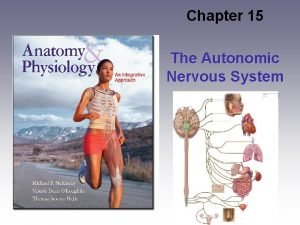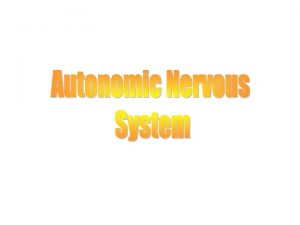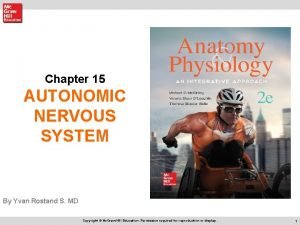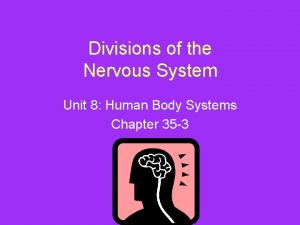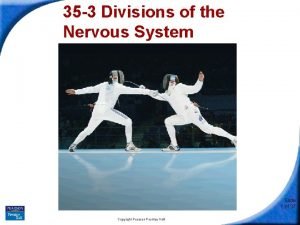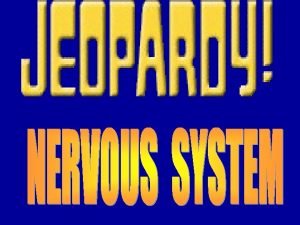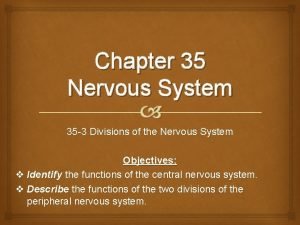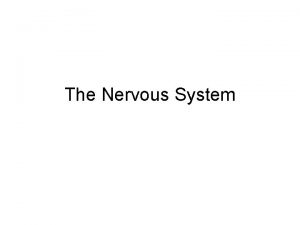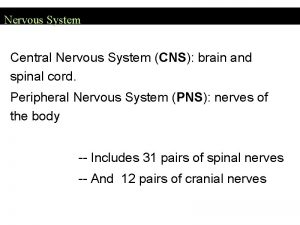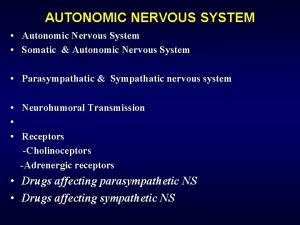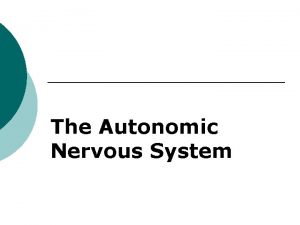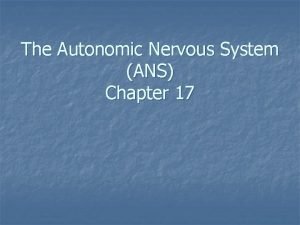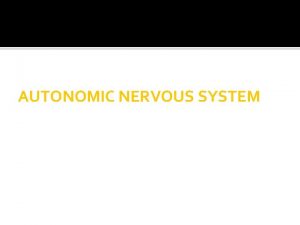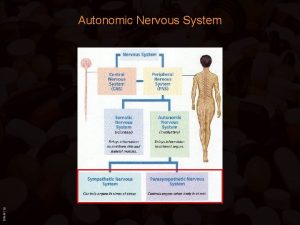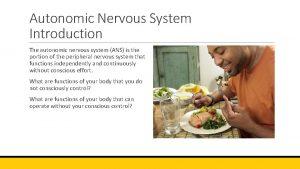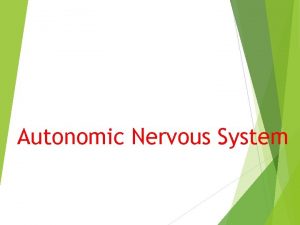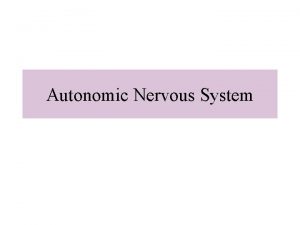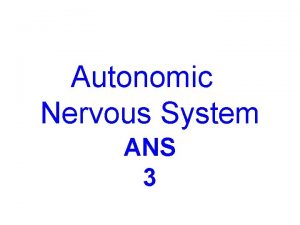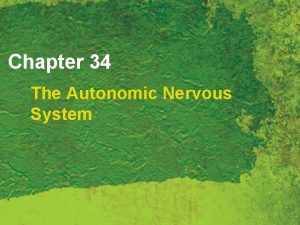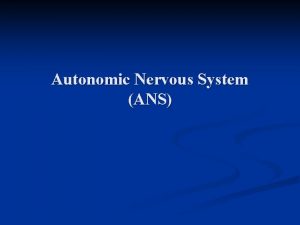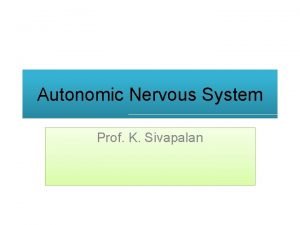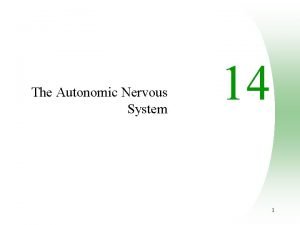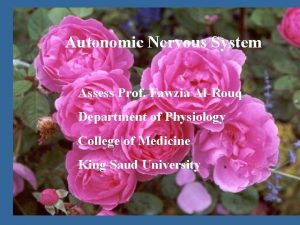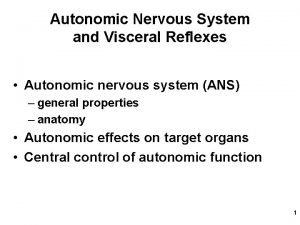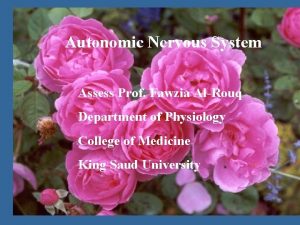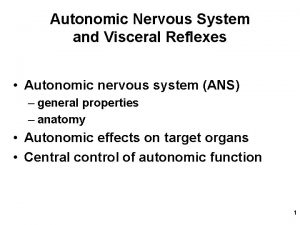CHAPTER 9 Autonomic Nervous System ANS Divisions of


























- Slides: 26

CHAPTER 9 Autonomic Nervous System (ANS) • Divisions of ANS – Sympathetic – Parasympatheitc • Functions of ANS • Control of ANS Dr. Hameed Al-Sarraf Dept. Physiology hameed@hsc. edu. kw

Autonomic Nervous System • Nervous system that controls many involuntary functions of the body. • ANS effects (controls) organs which are under involuntary control. • Effectors of ANS usually are: – Cardiac Muscle – Smooth Muscle – Glands HEART Many internal Organs


Divisions of ANS • 1 - Sympathetic (Thoracolumbar) Division • 2 - Parasympathetic (Craniosacral) Division.

Sympathetic hain Thoracolumbar

Sympathetic Chain

Sympathetic Chain

Parasympathetic Vagus Craniosacral

Parasympathetic


Innervation of Body Organs - In the body there are organs which are innervated by both sympathetic and parasympathetic systems: - Heart - Digestive tract - Pupil of the eye - Salivary glands, etc -There are organs with only sympathetic innervation: - Adrenal medulla - Sweat glands - Most blood vessels

Functions of ANS 1 - Sympathetic system: -Mass discharge of sympatheic system prepares the body for activity (Fight/Flight). - Excitation of sympathetic centers will cause: - Increase in heart rate. - increase in blood pressure, - blood glucose is elevated - increase in the rate of metabolism - mental activity is also raised, - blood is diverted to skeletal muscle. 2 - parasympathetic system: usually has opposite effects to those of sympathetic system. Excitation of parasympathetic causes: - decrease in heart rate, - increase blood flow to the digestive system, - increase activity of the digestive system.

Sympathetic Tone • Slow Fast rateofofaction potentials Vessel diameter at rest Vasoconstriction

Sympathetic Tone • Slow Stop sending rate of action potentials Vessel diameter at rest Vasodilatation

Sympathetic and Prasympathetic Tone - Normally both symathetic and parasympathetic systems continuously transmit action potentials (signals) at low rate throughout their nerve fibers. - By doing this the ANS can have both positive and negative effects on its effector organs: e. g control of blood vessel diameter by sympathetics, Fast rate of action potentials Sympathetic tone slow rate of action potentials Stop sending action potentials Vasoconstriction vessel diameter at rest Vasodialatation

Examples of Sympathetic System in Action Mass discharge (activation) of sympathetic system prepares the body for activity Example 1: Blood flow to muscle in exercise: Sympathetic nervous system causes blood shift to muscle during exercise by vasoconstriction of blood vessels of all other organs except heart and brain. Example 2: Liver: Stimulation of glycogenolysis to produce glucose which will be release into blood to provide muscle with fuel.

Examples of Parasympathetic System in Action Activation of parasympathetics usually has opposite effects to the sympathetics. Example 1: on gastrointestinal tract: Parasympathetic system causes increased blood flow, motility and secretion of gastrointestinal tract (e. g. stomach, small intestine) Example 2: Heart and lungs: Reduced heart rate and constriction of air tubes (bronchioles) in the lung.

Neurotransmitters of the ANS 1 - Acetylcholine (ACh)- the transmission is said to be cholinergic. - ACh is the transmitter released by: - all preganglionic fibers (in both sympathetic and parasympathetic) - most parasympathetic postganglionic fibers - some sympathetic postganglionic fibers 2 - Norepinephrine (noradrenaline)- the transmission is said to be adernergic. - Norepinephrine is the transmitter released by: - most postganglionic sympathetic fibers, 3 - Non-adernergic non-cholinergic (NANC)- the transmitter is neither ACh nor NE - proposed candidates are: ATP, VIP, and NO.

Preganglionic Postganglionic *Some sympathetics that innervate blood vessels and all sympathetics that supply sweat glands release acetylcholine (ACh) as their neurotransmitter.

Receptors - NE causes excitation to some tissues while it inhibits others. This is due to the presence of different receptors on the target cells. - There are two types of adernergic receptors: - a-adernergic receptors - b-adernergic receptors - ACh also has two types of receptors: - Nicotinic - Muscarinic

Adernergic Stimulation 1 - Binding of epinephrine or norepinephrine (NE) to a-receptor causes increase in cytoplasmic Ca++ levels: Endoplasmic Reticulum Membrane NE a-receptor Second messenger Phospholipase C Inositol triphosphate (IP 3) Closed Ca++ channels Increase cytoplasmic Ca ++ receptor Opening Ca++ channels

Adernergic Stimulation 2 - Binding of epinephrine or norepinephrine to b-receptor stimulates the production of cyclic adonesine monophosphate (c. AMP). Membrane NE b-receptor Adenylate cyclase (inactive) Second messenger Cytoplasm Adenylate cyclase (active) ATP c. AMP Protein kinase (inactive) Protein kinase (active) Catalyse many Reactions in the cell

Cholinergic Stimulation Nicotinic receptors = n Muscarinic receptors = m Always excitatory Mainly excitatory but with exceptions n Brain Parasympathetic ACh Sympathetic somatic Parasympathetic ACh m n n ACh Adernal Medulla NE n m ACh

Control of the ANS by Higher Brain Centers Hypothalamus Contain centers which control: Medulla Oblongata cardiovascular, pulmonary, urinary, reproductive and digestive system. Preganglionic Sensory Inputs Postganglionic Effector Organs

Control of ANS by Centers in Brain stem – mainly controls vascular system and respiration. Hypothalamus- Medulla Oblongata -Cardiovascular system; stimulation of: - posterior hypothalamus causes increase in blood pressure and heart rate, - anterior hypothalamus causes decrease in blood pressure and heart rate. -Body temperature: - changes in blood temperature in anterior hypothalamus causes several mechanisms to operate for temperature regulation. - Body water- secretion of ADH and signals to initiate thirst - Feeding – hunger and satiety centers - Excitement and rage- perifornical nucleus in hypothalamus - Endocrine function – neurosecretory substances secretion to anterior pituatory.

Reflex Effects of Sensory Inputs to Brain Centers These receptors are different than cell receptors ! These are sensory receptors Organ Type of Receptor Lung Stretch receptor Reflex Effect inhalation is inhibited and heart rate increase Aorta Chemoreceptor Baroreceptor increase breathing and heart rate decrease in heart rate Heart Stretch receptor increase volume of urine excreted and decrease in heart rate G. I. Tract Stretch receptor feeling of satiety
 Nervous system def
Nervous system def Skeletal muscle autonomic nervous system
Skeletal muscle autonomic nervous system Autonomic nervous system consists of
Autonomic nervous system consists of Autonomic nervous system pathway
Autonomic nervous system pathway Ans
Ans Autonomic nervous system
Autonomic nervous system The autonomic nervous system controls
The autonomic nervous system controls Autonomic nervous system visceral
Autonomic nervous system visceral Autonomic dysreflexia
Autonomic dysreflexia 副交感神経
副交感神経 8 divisions of the nervous system
8 divisions of the nervous system 35-3 divisions of the nervous system
35-3 divisions of the nervous system Divisions of the nervous system
Divisions of the nervous system Section 35-3 divisions of the nervous system
Section 35-3 divisions of the nervous system Nervous system divisions
Nervous system divisions Central and peripheral nervous system
Central and peripheral nervous system Part of nervous system
Part of nervous system Label the parts of the main division of the nervous system
Label the parts of the main division of the nervous system Identify each type of neuronal pool
Identify each type of neuronal pool Fundamentals of the nervous system and nervous tissue
Fundamentals of the nervous system and nervous tissue Fundamentals of the nervous system and nervous tissue
Fundamentals of the nervous system and nervous tissue Autonomic nerveous system
Autonomic nerveous system Nervous system and digestive system
Nervous system and digestive system Endocrine system vs nervous system
Endocrine system vs nervous system General mechanism of hormone action
General mechanism of hormone action Endocrine system and nervous system
Endocrine system and nervous system Chapter 7 the nervous system
Chapter 7 the nervous system





